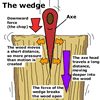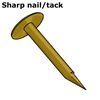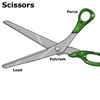 An axe is a good example of a wedge, as is any cutting or chopping
edge, such as a knife, a chisel, a pin or a nail. In these cases and in
all wedges, there are two or more inclined planes tapering to an edge
or a point.
An axe is a good example of a wedge, as is any cutting or chopping
edge, such as a knife, a chisel, a pin or a nail. In these cases and in
all wedges, there are two or more inclined planes tapering to an edge
or a point.
When using an axe the sharp edge penetrates the surface of a log of wood, then the sides of the wedge split it apart by applying a large sideways force. Friction reduces the efficiency of a wedge so sometimes extra force has to be applied by a heavy hammer.
 A blow with a hammer forces the point of a nail into wood. If you
examine the point of a nail carefully you will see that it is really four
wedges, enabling it to pierce wood easily, then push the fibres apart.
This last action increases friction between the wood and the nail, holding
the nail firmly in place. Sometimes a nail splits the wood when the sideways
force is more than the wood grain can withstand. A pre-drilled hole helps
prevent this from happening.
A blow with a hammer forces the point of a nail into wood. If you
examine the point of a nail carefully you will see that it is really four
wedges, enabling it to pierce wood easily, then push the fibres apart.
This last action increases friction between the wood and the nail, holding
the nail firmly in place. Sometimes a nail splits the wood when the sideways
force is more than the wood grain can withstand. A pre-drilled hole helps
prevent this from happening.
More uses for wedges
 Other examples of wedges in action are scissors slicing through paper
and pushing the separated halves apart, a chisel slicing a thin layer
from wood, and a guillotine slicing through paper or metal.
Other examples of wedges in action are scissors slicing through paper
and pushing the separated halves apart, a chisel slicing a thin layer
from wood, and a guillotine slicing through paper or metal.
A wedge can be used to keep a door open. Friction holds the wedge to the floor and the door is prevented from rising further up the wedge by its hinges. This is a simple application of the wedge and the reverse can apply. By tapping a wedge into a gap a heavy object can be raised and secured.

|
Door wedge. |
What about wedge angle?
 The wedge of a sharp knife has a very small angle between the
sides of the wedge. This means that it can cut easily but is not very
good at splitting. An axe has a larger angle between the wedges and can
cut and split wood fairly effectively. A blockbuster on the other hand
has a high wedge angle so is not good for cutting but excellent for splitting
logs for example where there is already a fine split.
The wedge of a sharp knife has a very small angle between the
sides of the wedge. This means that it can cut easily but is not very
good at splitting. An axe has a larger angle between the wedges and can
cut and split wood fairly effectively. A blockbuster on the other hand
has a high wedge angle so is not good for cutting but excellent for splitting
logs for example where there is already a fine split.

Sometimes a combination of angles is used, for example in a chisel. The
first wedge has an angle for cutting, then the angle changes to push the
shaving away from the work.
| Copyright owned by the State of Victoria (Department of Education and Early Childhood Development). Used with Permission. |
|
|||||||||||||||||||||||